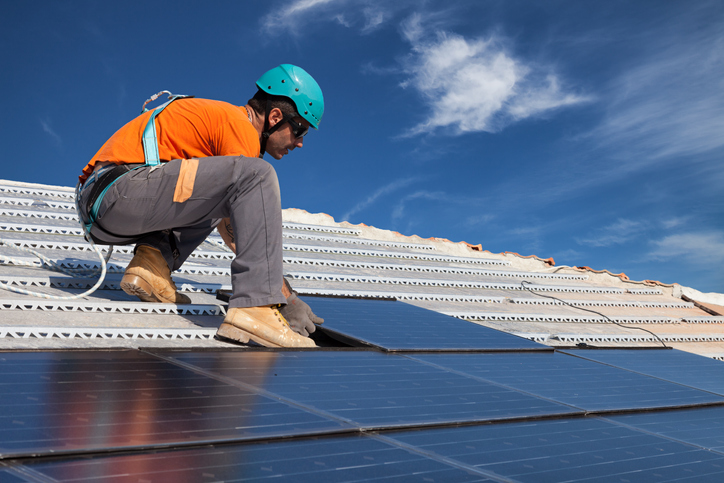3 issues that impact the solar industry: Mounting, Monitoring and Maintenance

Authored by Allianz
Did you know that at any given moment, the Earth receives 173,000 terawatts of solar energy? This is over 10,000 times the total global energy consumption within the same timeframe1!
With such vast quantities of free and green energy available, and in light of COP27 and the fight against climate change, it’s essential that investment in solar photovoltaic (PV) power continues.
The UK’s total solar capacity stands at 15 GW 2, with 49% coming from ground-mounted or standalone solar installations 3. But these installations have their challenges, with many of these well documented, such as the problems of breakdown and/or failure of aging technology; the risks posed by changing weather patterns; issues surrounding workmanship quality, and time delays relating to planning permission. There are, however, three further issues that impact the long-term productivity and sustainability of the solar industry – Mounting, Monitoring and Maintenance.
Mounting
This relates to the way solar equipment is installed. Inadequate and unsafe installation of solar equipment pose significant dangers, both in terms of financial implications and potential threats to life. Incorrect installation, whether on the ground or roof, increases the risk of panels dislodging during storms or high winds. On roof mounted installations this can also impact the structural integrity of the building.
Ground mounted solar PV installations ideally should be fixed to the ground using adequate concrete solutions, such as concrete shoes, with piled or screw foundations. If the piles or screws have been installed appropriately, this is the securest mounting method, improving the likelihood that solar equipment will withstand severe weather events.
Where the land is not suitable for piled foundations (such as areas of archeological significance or decommissioned quarries), ballasting systems, whereby installations are secured by stone, can be an ideal alternative. However, for a ballast system to effectively ensure the integrity of a solar array, wind load calculations must have been conducted to identify the specific amount of ballast required and ensure that sufficient load margins are incorporated.
The integrity and positioning of the ballast should be regularly monitored as, overtime, ballast has a tendency to shift and become unstable. This compromises the system and makes the solar array more susceptible to damage by weather events. As these weather events are intensifying, the requirement for the safe mounting of solar panels is becoming increasingly important.
Monitoring
Many solar installations are equipped with Supervisory Control and Data Acquisition (SCADA) for real-time monitoring, issue detection and resolution. Automatic trip features add an extra layer of risk mitigation, preventing the installation from continuing to run in a fault condition and minimising the risk of any potential damage.
This live monitoring of installations can greatly reduce the risk of equipment failure and allows operators to ensure that they’re running at peak performance. Faults and defects can be picked up and rectified early, helping to protect equipment and investment.
Without online monitoring, it’s much more difficult to check if an array is operating efficiently. Smaller installations may not be fitted with full SCADA, but should still possess live monitoring to allow performance data and for operators to act in the event of faults.
Maintenance
There is a common misconception that, once installed, panels can be left alone and maintenance is not required. Solar panels are not a fit and forget technology, and require regular, preferably annual, maintenance as well as regular inspections to help identify potential issues early on and prevent major problems down the line. As with any electrical equipment exposed to changeable weather over time, connections can become lose and wiring can become dislodged. This increases the likelihood of breakdown and potentially fire.
One of the crucial elements of maintenance is cleaning. When dirt and debris build up on solar panels, it prevents sunlight reaching them, which can produce hot spots. Furthermore, dirty panels are less efficient and have less output, increasing the time taken to see a return on investment. Self-cleaning panels are available in the market which have a hydrophobic surface, meaning that water droplets cannot stick to it. However, for cells situated in dusty environments, rain alone is not enough to ensure solar panels remain free from dirt build-up throughout a year, let alone a lifetime.
Designing and operating productive, efficient and reliable renewable energy infrastructure is one of the key tools to slow and potentially reverse the impacts of climate change. Allianz actively seeks to work with clients who focus on risk management and we’re here to offer protection and peace of mind to owners who are running an efficient solar array designed for long-term, uninterrupted output.
Electrical inspections for solar installations
Our electrical fixed wiring inspections can help identify any issues and faults with your customers’ solar installations. For more information, please contact special.services@allianz.co.uk





